Epson Pro Cinema 6010 User Manual
PowerLite® Pro Cinema 6010
Home Theater Projector
User’s Guide
Contents
Introduction |
5 |
Projector Parts |
6 |
Remote Control |
8 |
Optional Accessories |
9 |
Registration and Warranty |
9 |
Using This Manual |
10 |
Setting Up the Projector |
11 |
Choose a Location |
11 |
Installing the Projector |
15 |
Connecting the Cables |
17 |
Connecting Video and Computer Equipment |
17 |
Making Other Connections |
19 |
Installing Batteries in the Remote Control |
20 |
Turning the Projector On and Off |
20 |
Turning On the Projector |
20 |
Turning Off the Projector |
21 |
Selecting the Image Source |
21 |
Positioning the Image |
22 |
Making Basic Adjustments |
25 |
Focusing and Zooming |
25 |
Choosing the Aspect Ratio |
26 |
Viewing 3D images |
27 |
Projecting in Split Screen mode |
28 |
Choosing the Color Mode |
29 |
2 Contents
Advanced Color Adjustments |
30 |
Adjusting the Gamma Setting |
31 |
Adjusting RGBCMY |
32 |
Locking the Projector |
32 |
Making Detailed Adjustments |
34 |
Using the Menu System |
34 |
Changing How the Menus Display |
35 |
Adjusting the Picture Quality |
36 |
Input Brightness Settings |
36 |
Sharpness and Picture Quality Settings |
38 |
Color Settings |
39 |
3D Setup |
41 |
Adjustments for Computer Images |
43 |
Split Screen Setup |
43 |
Selecting Memory Settings and Resetting the Projector |
45 |
Creating Memory Settings |
45 |
Selecting Memory Settings |
45 |
Renaming Memory Settings |
46 |
Deleting Saved Memory Settings |
46 |
Resetting the Projector |
47 |
Customizing Projector Features |
48 |
Image Sizing |
48 |
Screen Options |
49 |
Other Setup Options |
49 |
Adjusting the LCD Alignment |
51 |
Using HDMI Link |
54 |
Setting Up HDMI Link |
54 |
Changing HDMI Link Settings |
55 |
Contents 3
Maintenance |
56 |
Cleaning the Lens |
56 |
Cleaning the 3D Glasses |
57 |
Cleaning the Projector Case |
58 |
Cleaning and Replacing the Air Filter |
58 |
Replacing the Lamp |
60 |
Resetting the Lamp Usage Timer |
63 |
Checking the Projector Status |
63 |
Storing the Projector |
64 |
Transporting the Projector |
64 |
Problem Solving |
65 |
What To Do When the Lights Come On or Flash |
65 |
Solving Picture Problems |
67 |
Solving Remote Control Problems |
71 |
Where to Get Help |
72 |
Specifications |
73 |
Notices |
77 |
Important Safety Information |
77 |
FCC Compliance Statement |
79 |
Copyright Notice |
80 |
A Note Concerning Responsible Use of Copyrighted Materials |
80 |
Trademarks |
81 |
4 Contents
Introduction
The PowerLite® Pro Cinema 6010 projector lets you enjoy theater-quality 3D images in the relaxing environment of your own home. Designed especially for home cinema use, it offers these outstanding features:
■Native 1080p (1920 × 1080) resolution, dynamic contrast ratio up to 200,000:1 and up to 2400 lumens of brightness (color and white light output) for incredibly rich, sharp images in any room lighting
■Auto Iris system that constantly controls the light output based on the gamma and black/white levels of your projected content, for perfectly adjusted images and deepest blacks
■EPSON C2Fine® 3LCD technology for reliable picture quality, increased contrast ratio and uniform colors
■1080Perfect™ video processing for more film-like images free of noise or artifacts
■10-bit color quality for unmatched color accuracy, with over a billion colors available
■HDMI® (High-Definition Multimedia Interface®) ports for superior, uncompressed digital video
■Built-in cinema filter and Fujinon® lens for exceptional picture quality
■True 16:9 wide-format projection
■Flexible setup configurations, including front projection and ceiling mounted, with vertical and horizontal lens shift dials for offset placement
Introduction 5

Projector Parts
Front
Remote receiver |
|
Lamp cover |
|
|
Zoom ring |
Horizontal |
|
lens shift dial |
Vertical lens shift dial |
|
|
|
Power and |
|
warning |
Air exhaust |
lights |
|
Control |
|
panel cover |
Focus ring |
Control panel |
Auto lens |
Air filter cover |
|
|
shutter |
|
Air intake |
Adjustable foot |
Projector lens |
|
Back
|
|
|
|
|
|
|
|
|
|
|
Component ports |
PC port |
Trigger out port (12V DC |
|||||
|
|
|
|
|
|
|
|
|
|
|
200mA max) |
|||||||
|
|
|
|
|
|
Cable clip holes |
|
|||||||||||
|
|
|
|
|
|
|
|
|
|
|||||||||
|
|
|
|
|
|
|
|
|
|
|
|
|
Video port |
RS-232C port |
|
|
|
|
|
|
|
|
|
|
|
|
|
|
|
|
|
|
|
|
|
|
|
|
|
|
|
|
|
|
|
|
|
|
|
|
|
|
|
|
|
|
|
|
|
|
|
|
|
|
|
|
|
|
|
|
|
|
|
|
|
|
|
|
|
|
|
|
|
|
|
|
|
|
|
|
|
|
|
|
|
|
|
|
|
|
|
|
|
|
|
|
|
|
|
|
|
|
|
|
|
|
|
|
|
|
|
|
|
|
|
|
|
|
|
|
|
|
|
|
|
|
|
|
|
|
|
|
|
|
|
|
|
|
|
|
|
Kensington® lock port
External 3D IR port |
HDMI ports |
Power inlet |
|
|


 Power switch
Power switch
6 Introduction
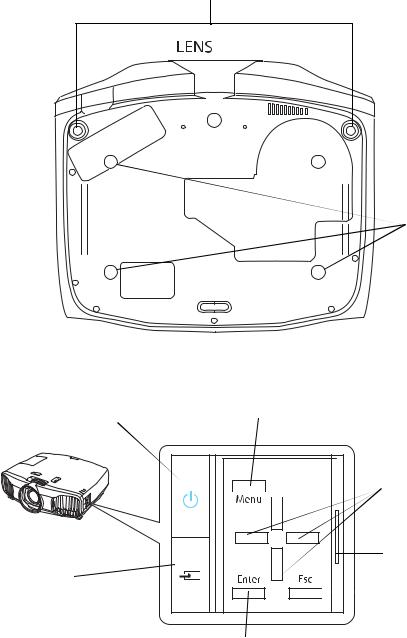
Bottom
Front adjustable feet
Mounting bracket attachment points
Projector Control Panel
Power button |
Menu button |
Menu navigation/ vertical keystone

 buttons
buttons
Retractable cover
Source button
 Escape button
Escape button
Enter button
Introduction 7
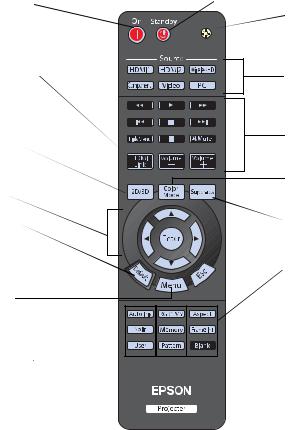
Remote Control
On button
Turns projector on
HDMI Link button
Enables and disables the HDMI link function
2D/3D button
Toggles between 2D and 3D projection
Menu navigation buttons
Default button
Resets menu selection to default values
Menu button
Displays the projector’s menus
Auto Iris button
Adjusts the Auto Iris function
Split button
Adjusts the Split Screen function
User button
Function can be set by the user from the Settings menu
Standby button
Turns projector off
Illumination button
Lights the remote control buttons for easy viewing
Source buttons
Switch between equipment connected to the projector
HDMI Link control buttons
Control playback of a linked video device
Color Mode button
Quickly change color settings to match room lighting
Super-res button
Adjusts the Super-res setting on or off
Aspect button
Changes the picture’s aspect ratio (not available for all sources)
Frame Int button
Adjusts the Frame Interpolation setting
Blank button
Temporarily stops projection or hides the menu screen
RGBCMY button
Displays the color adjustment menu
Memory button
Accesses the memory menu
Pattern button
Displays test patterns to adjust the image
8 Introduction

Optional Accessories
Epson provides the following optional accessories for the projector:
Product |
Part number |
|
|
Replacement lamp |
V13H010L69 |
|
|
Air filter replacement |
V13H134A39 |
|
|
Kensington security lock (anti-theft device) |
ELPSL01 |
|
|
Projector mount |
CHF2500 |
|
|
Computer cable (6 feet [1.8 meters]) |
F3H982-06 |
|
|
3D active shutter glasses |
V12H483001 |
|
|
External 3D IR emitter |
V12H484001 |
|
|
Fixed Anamorphic Lens Kit |
ELPFALKED |
|
|
Motorized Anamorphic Lens Kit |
ELPALK3 |
|
|
In addition to the accessories listed above, 1-year and 2-year extended service plans are available. You can purchase these plans and other accessories from an authorized EPSON reseller. To find the nearest reseller, please call 800-GO-EPSON (800-463-7766). To purchase online, visit www.epsonstore.com (U.S. sales) or www.epson.ca (Canadian sales).
Registration and Warranty
Your projector comes with a basic three-year carry-in warranty. For details, see the Quick Setup sheet.
In addition, Epson offers free Extra CareSM Home Service. In the unlikely event of an equipment failure, you won’t have to wait for your unit to be repaired. Instead, Epson will ship you a replacement unit anywhere in the United States, Canada, or Puerto Rico. See your
Extra Care Home Service brochure for details.
To register, simply follow the registration instructions on the CD, or register online at epson.com/webreg. Registering also lets you receive special updates on new accessories, products, and service.
Introduction 9

Using This Manual
This book contains all the information you need to use the projector, in addition to basic setup and maintenance instructions, troubleshooting tips, important safety instructions, specifications, and warranty information.
Please follow these guidelines as you read through the manual:
Warning: Must be followed carefully to avoid bodily injury.
Caution: Must be observed to avoid damage to your equipment.
Note: Contains important information about your projector.
Tip: Contains helpful projection tips.
Need additional help? Take advantage of Epson’s automated support services 24 hours a day at epson.com/support (U.S.) or epson.ca/support (Canada). Use this site to view FAQs or product information and e-mail Epson.
If you need more help, you can use the EPSON® PrivateLine® Support service. Call (800) 637-7661 and enter the PIN on the PrivateLine support card that came with your projector.7
10 Introduction
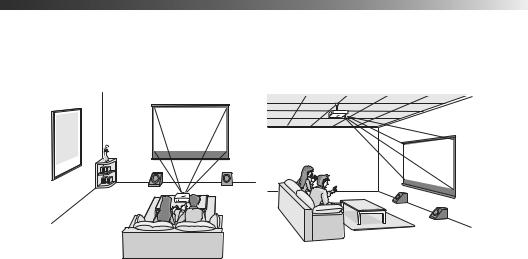
Setting Up the Projector
Follow the instructions in this section to choose a location for the projector, connect the cables, and display an image.
Choose a Location
You can install the projector for the viewing setups shown below, as well as rear projection.
Front |
|
|
|
Ceiling |
||
|
|
|
|
|
|
|
|
|
|
|
|
|
|
|
|
|
|
|
|
|
|
|
|
|
|
|
|
|
|
|
|
|
|
|
Setting Up the Projector 11
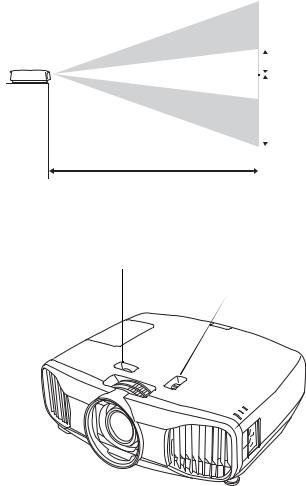
Keep the projector level and place it at a height so its lens is even with the top or the bottom of the screen and is centered horizontally. If this is not possible, use the lens shift dials to reposition the image. You can use lens shift to move the image up or down by nearly its full height, and left or right by about one-half its width (for details, see page 22).
|
|
|
Offset A |
|
|
|
|
|
|
|
|
|
|
|
Offset B |
|
|
|
|
|
|
|
|
|
|
|
|
|
|
|
Offset refers to distance from |
|
|
|
|
|
|
|
|
|
|
|
bottom of image to center of |
Projection distance |
|
|
lens using maximum lens shift. |
If you place the projector off to the side, aim it straight ahead (rather than at the center of the screen), then use the horizontal lens shift dial to center the image on the screen.
Horizontal lens shift dial
Vertical lens shift dial
Caution: Do not try to move the lens by hand, or you may damage the projector. Always use the lens shift dials to change the lens position.
12 Setting Up the Projector
The size of the image is determined by the distance from the projector’s lens to the screen. Depending on your display settings and how you use the Zoom ring, the actual size may differ. Use these tables as a guide for projector placement:
16:9 aspect ratio
|
Diagonal image size |
|
|
Horizontal |
Projection distance |
(width × height) |
Offset A |
Offset B |
Offset |
|
|
|
|
|
3.8 to 8.3 feet |
40 in. (35 × 20 in.) |
9.1 in. |
28.7 in. |
–15.4 to 15.4 in. |
1.17 to 2.52 m |
101.6 cm (89 × 50 cm) |
23 cm |
73 cm |
–39 to 39 cm |
|
|
|
|
|
5.8 to 12.5 feet |
60 in. (51 × 28 in.) |
13.8 in. |
43.0 in. |
–23.2 to 23.2 in. |
1.77 to 3.80 m |
152.4 cm (130 × 75 cm) |
35 cm |
109 cm |
–59 to 59 cm |
|
|
|
|
|
7.8 to 16.7 feet |
80 in. (71 × 39 in.) |
18.1 in. |
57.5 in. |
–30.7 to 30.7 in. |
2.38 to 5.08 m |
203.2 cm (180 × 100 cm) |
46 cm |
146 cm |
–78 to 78 cm |
|
|
|
|
|
9.8 to 20.9 feet |
100 in. (87 × 47 in.) |
22.8 in. |
71.7 in. |
–38.6 to 38.6 in. |
2.98 to 6.36 m |
254 cm (220 × 120 cm) |
58 cm |
182 cm |
–98 to 98 cm |
|
|
|
|
|
11.8 to 25.1 feet |
120 in. (106 × 59 in.) |
27.2 in. |
86.2 in. |
–46.1 to 46.1 in. |
3.59 to 7.64 m |
305 cm (270 × 150 cm) |
69 cm |
219 cm |
–117 to 117 cm |
|
|
|
|
|
14.7 to 31.4 feet |
150 in. (130 × 75 in.) |
33.9 in. |
107.5 in. |
–57.9 to 57.9 in. |
4.50 to 9.56 m |
381 cm (330 × 190 cm) |
86 cm |
273 cm |
–147 to 147 cm |
|
|
|
|
|
17.7 to 37.7 feet |
180 in. (173 × 98 in.) |
40.9 in. |
129.1 in. |
–69.3 to 69.3 in. |
5.39 to 11.49 m |
457 cm (440 × 250 cm) |
104 cm |
328 cm |
–176 to 176 cm |
|
|
|
|
|
4:3 aspect ratio
|
Diagonal image size |
|
|
Horizontal |
Projection distance |
(width × height) |
Offset A |
Offset B |
Offset |
|
|
|
|
|
4.7 to 10.1 feet |
40 in. (32 × 24 in.) |
11.0 in. |
35.0 in. |
–18.9 to 18.9 in. |
1.44 to 3.09 m |
101.6 cm (81 × 61 cm) |
28 cm |
89 cm |
–48 to 48 cm |
|
|
|
|
|
7.1 to 15.3 feet |
60 in. (47 × 35 in.) |
16.5 in. |
52.8 in. |
–28.3 to 28.3 in. |
2.18 to 4.66 m |
152.4 cm (120 × 90 cm) |
42 cm |
134 cm |
–72 to 72 cm |
|
|
|
|
|
9.6 to 20.4 feet |
80 in. (63 × 47 in.) |
22.0 in. |
70.1 in. |
–37.8 to 37.8 in. |
2.92 to 6.23 m |
203.2 cm (160 × 120 cm) |
56 cm |
178 cm |
–96 to 96 cm |
|
|
|
|
|
12 to 25.5 feet |
100 in. (79 × 59 in.) |
27.9 in. |
87.8 in. |
–47.2 to 47.2 in. |
3.66 to 7.79 m |
254 cm (200 × 150 cm) |
71 cm |
223 cm |
–120 to 120 cm |
|
|
|
|
|
14.4 to 30.7 feet |
120 in. (94 × 71 in.) |
33.5 in. |
105.5 in. |
–56.3 to 56.3 in. |
4.40 to 9.36 m |
305 cm (240 × 180 cm) |
85 cm |
268 cm |
–143 to 143 cm |
|
|
|
|
|
18 to 38.4 feet |
150 in. (118 × 91 in.) |
41.7 in. |
131.5 in. |
–70.5 to 70.5 in. |
5.51 to 11.71 m |
381 cm (300 × 230 cm) |
106 cm |
334 cm |
–179 to 179 cm |
|
|
|
|
|
Setting Up the Projector 13
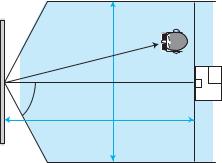
4:3 aspect ratio (continued)
|
Diagonal image size |
|
|
Horizontal |
Projection distance |
(width × height) |
Offset A |
Offset B |
Offset |
|
|
|
|
|
24.2 to 51.3 feet |
200 in. (161 × 118 in.) |
55.5 in. |
175.6 in. |
–94.1 to 94.1 in. |
7.36 to 15.62 m |
508 cm (410 × 300 cm) |
141 cm |
446 cm |
–239 to 239 cm |
|
|
|
|
|
To determine the exact image size when you know the projection distance (or the exact projection distance when you know the desired image size), you can use the Image Size Calculator. This program is available on the EPSON website at epson.com/support (U.S.) or epson.ca/support (Canada).
Also keep these considerations in mind:
■Make sure there is plenty of space for ventilation around and under the projector. Do not set the projector on top of loose materials that could block the vents underneath.
■Make sure the projector is within 9.8 feet (3 m) of a grounded electrical outlet or extension cord.
In order to view 3D images correctly, 3D glasses must be worn within proper range of the projector. Use the image below to determine the ideal distance for 3D projection (the shading represents the 3D viewing area):
60º |
16.5 ft (5 m) |
13 ft (4 m) |
Use the optional external 3D emitter and a shielded twisted pair Category 5, RJ45 straight network cable (make sure to use a regular Ethernet network patch cord, not a crossover-type cable) of 32 feet (10 m) or shorter if you cannot view the 3D image normally or if the projector is located more than 16.5 feet (5 m) from the viewing area. See “Optional Accessories” on page 9 for ordering information.
14 Setting Up the Projector

Installing the Projector
To install the projector, you first need to determine the location, based on the size of your screen (maximum diagonal image size). Use the tables on page 13 as a guide to positioning the projector.
To suspend the projector from a ceiling, you will need the included projector mount designed for the projector. Follow the instructions included with the mount to install the projector.
Warning: When installing or adjusting the ceiling mount, do not use adhesives to prevent the screws from loosening and do not use any type of oil or lubricant. These may cause the projector casing to crack and the projector may fall, causing serious injury and serious damage to the projector.
If you install the projector on the ceiling, you will need to invert the picture so that it appears right side up. Follow these steps:
1.Press the Menu button on the remote control.
2.Open the Settings menu, then select Projection.
3.Select Front/Ceiling.
4.Press the Menu button to exit the menu system.
Setting Up the Projector 15
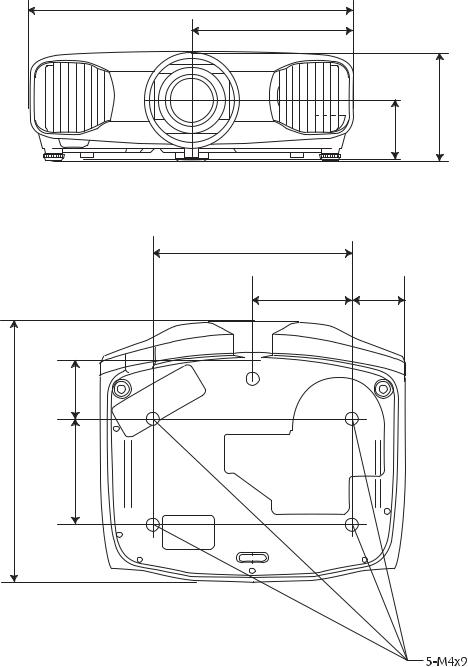
The following illustrations show the dimensions of the projector:
18.3 in. (466 mm)
9.2 in. (233 mm)
6.2 in.
(159 mm)
3.3 in.
(83 mm)
11.8 in. (300 mm) |
|
|
3.3 in. |
5.9 in. (150 mm) |
(83 mm) |
LENS |
|
2.4 in. |
|
(60 mm) |
|
15.6 in. |
|
(396 mm) |
|
6.3 in. |
|
(160 mm) |
|
16 Setting Up the Projector
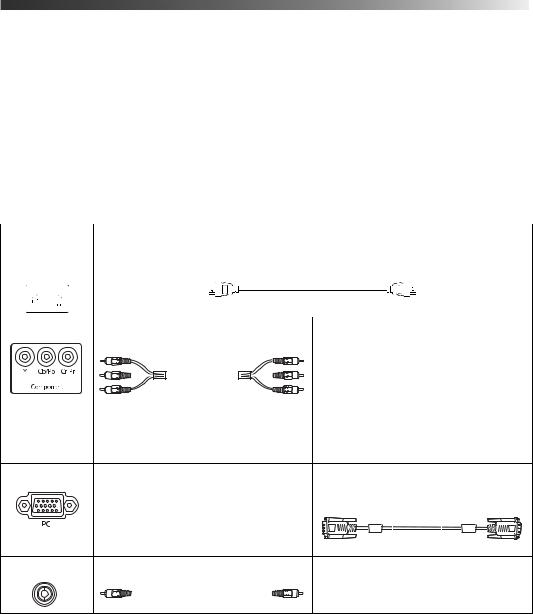
Connecting the Cables
Connecting Video and Computer Equipment
You can connect the projector to many types of video equipment, such as a Blu-ray Disc™/DVD player, digital tuner, cable or satellite box, video game console, camcorder, or digital camera. You can also connect it to a desktop or laptop PC or Apple® Mac® system. For details on compatible video formats, see page 75.
You can connect up to five pieces of equipment at the same time, using any of the commercially available cables shown below:
Port name |
Video equipment connection |
Computer connection |
||||||||||||||
|
|
|
|
|
|
|
|
|
|
|
|
|
|
|
|
|
HDMI1/ |
Use an HDMI cable (version 1.4 or higher required for 3D): |
|||||||||||||||
HDMI2 |
|
|
|
|
|
|
|
|
|
|
|
|
||||
|
|
|
|
|
|
|
|
|
|
|
|
|
|
|
|
|
|
|
|
|
|
|
|
|
|
|
|
|
|
|
|
|
|
|
|
|
|
|
|
|
|
|
|
|
|
|
|
|
|
|
|
|
|
|
|
|
|
|
|
|
|
|
|
|
|
|
|
Component |
Use a component video cable |
— |
||||||||||||||
|
|
|
|
|
(with RCA-style connectors): |
|
|
|
||||||||
|
|
|
|
|
|
|
|
|
|
|
|
|
|
|
|
|
|
|
|
|
|
|
|
|
|
|
|
|
|
|
|
|
|
|
|
|
|
|
|
|
|
|
|
|
|
|
|
|
|
|
Connect the cable to the three component video ports. Match corresponding colors between the cable and the ports.
PC |
— |
Use a Mini D-sub, 15-pin monitor cable |
|
|
to connect to a computer RGB |
|
|
(monitor) port: |
Video |
Use an RCA video cable: |
— |
|
|
|
|
|
|
|
|
|
Setting Up the Projector 17

For best results, connect your video equipment to the HDMI port, if possible. If your equipment doesn’t support HDMI, connect it to either the Component (for high quality, component video) or Video (for composite video) port.
Note: You need to use a version 1.4 or higher HDMI cable to use the projector’s 3D features. If you aren’t sure if your HDMI cable is version 1.4 or higher, contact your cable manufacturer.
When you connect an HDMI cable to the projector, it is recommended that you fasten it with the included cable clip. Follow the steps below to install the cable clip.
Note: The included cable clips will fit most standard, round HDMI cables. The clips may not fit non-round or thick HDMI cables.
1.Connect the HDMI cable to one of the HDMI ports on the projector.
2.Insert the end of the cable clip anchor into the cable clip hole above the HDMI port, as shown below.
3.Place the open cable clip around the HDMI cable, but don’t lock it into place.
4.Slide the cable clip towards the projector and lock the clip onto the HDMI connector.
To remove the cable clip, unlock the clip and disconnect the HDMI cable. Then pinch the side of the cable clip anchor and carefully pull it out of the cable clip hole.
18 Setting Up the Projector
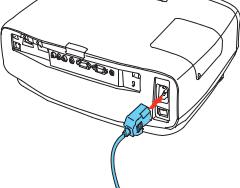
Making Other Connections
Connect the power cable and other cables described below, depending on how you plan to use the projector.
■ Plug the power cable into the projector and a grounded electrical outlet.
■To use an AV controller with the projector, connect a 9-pin null modem serial cable to the RS-232C port.
■To connect external devices such as motorized screens, connect a mini-jack stereo (3.5 mm) cable to the Trigger Out port and set the Trigger Out menu option to On. See page 51 for more information. The Trigger Out port uses a 12V DC (200 mA max) signal.
■To connect the optional External IR 3D Emitter, attach a shielded twisted pair Category 5, RJ45 straight network cable (make sure to use a regular Ethernet network patch cord, not a crossover-type cable) of no more than 32 feet (10 m) to both the emitter and the External 3D IR port on the back of the projector. See page 9 for part number and ordering information.
Setting Up the Projector 19
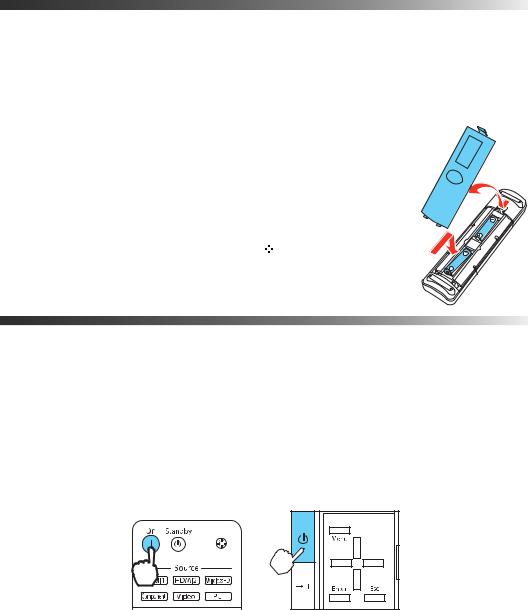
Installing Batteries in the Remote Control
The remote control uses two AA batteries.
Warning: Keep batteries away from children. If a battery is swallowed, contact your doctor immediately.
1. Release the tab and lift open the cover.
2.Insert two new AA batteries as shown.
3.Reinsert the cover and press it down until it clicks into place.
Aim the remote control at the screen, or at the front or back of the projector. Make sure you are within 32 feet (10 meters) of the projector.
If you suspect the batteries are weak, press the  illumination button. If the buttons do not glow, replace the batteries.
illumination button. If the buttons do not glow, replace the batteries.
Turning the Projector On and Off
Turning On the Projector
1.Turn on the power switch on the back of the projector.
2.Turn on any connected equipment you plan to use.
3.Press the On button on the remote control or the P power button on the projector.
Remote control |
Projector |
Note: To prevent children from turning on the projector, you can use the Child Lock feature. See page 32 for details.
If you’ll be using the projector at an altitude above 4921 feet (1500 meters), turn on High Altitude Mode so the fan can properly cool the projector at the high altitude air pressure. See page 51 for details.
20 Setting Up the Projector
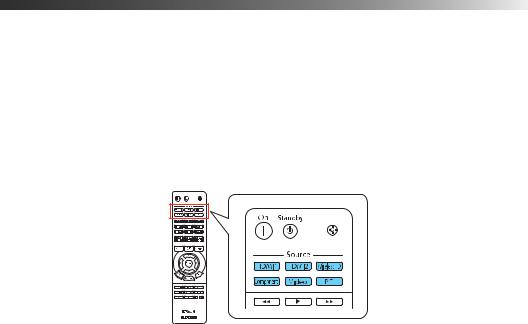
The power light flashes while the projector warms up. If you don’t see a picture, you may need to change the image source as described on page 21.
Turning Off the Projector
1.Turn off any equipment connected to the projector.
2.Press the P power button on the projector twice or press the Standby button on the remote control and wait for the power light to stop flashing.
3.Turn off the power switch on the back of the projector.
Caution: Turn off this product when not in use to prolong the life of the projector.
Selecting the Image Source
The source buttons on the projector and remote control let you switch between images from different pieces of equipment connected to the projector (such as a Blu-ray Disc/DVD player, cable or satellite box, or video game console).
Press the Source button on the remote control that corresponds to the port to which your video source is connected.
Note: There may be a brief delay when switching between sources.
Setting Up the Projector 21
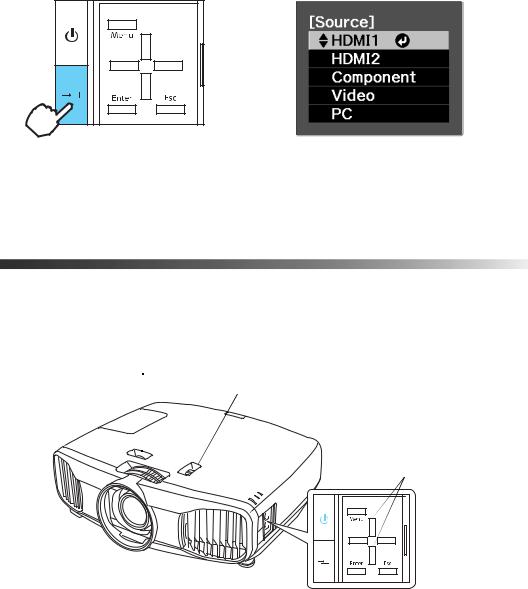
If you press the  source button on the projector, you see a list of available sources. Press the
source button on the projector, you see a list of available sources. Press the  source button to move through the list and select the desired source.
source button to move through the list and select the desired source.
Note: If an image does not appear, see “Problem Solving” on page 65.
To temporarily turn off the image and darken the screen, press the Blank button on the remote control. Press the Blank button again to return to normal viewing.
Positioning the Image
If the projector is not centered in front of the screen, use the lens shift dials and, if needed, vertical keystone buttons to correct the position and shape of the image.
Horizontal lens shift dial
Vertical lens shift dial
Vertical keystone buttons
Note: You can display a test pattern to help adjust the image position by pressing the Pattern button on the remote control. Press the Esc button to turn off the test pattern.
22 Setting Up the Projector
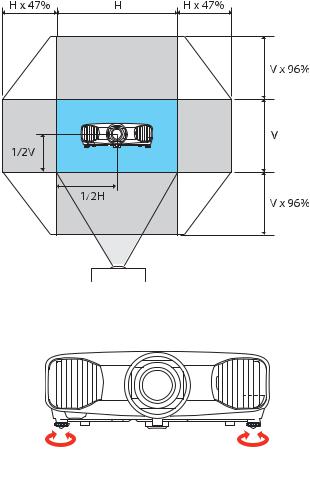
The vertical position (V) can be adjusted by up to 96% of the height of the screen, while the horizontal position (H) can be adjusted by up to 47% of the width of the screen.
If one side of the image is taller than the other, make sure the projector is parallel to the screen. If necessary, adjust the front feet so that the projector is horizontal.
Adjustable feet
Note: If the projected image shape is not rectangular, the projector is not level with the screen. It’s best to adjust the physical position of the projector to correct this. If you still can’t correct the image shape by adjusting the position of the projector, use the vertical keystone buttons to fix the image shape.
Setting Up the Projector 23

When setting up the projector, make sure that it is placed level to the screen in order to provide the best possible image quality. If you must set up the projector at an angle, use the vertical keystone buttons to correct the image shape.
24 Setting Up the Projector
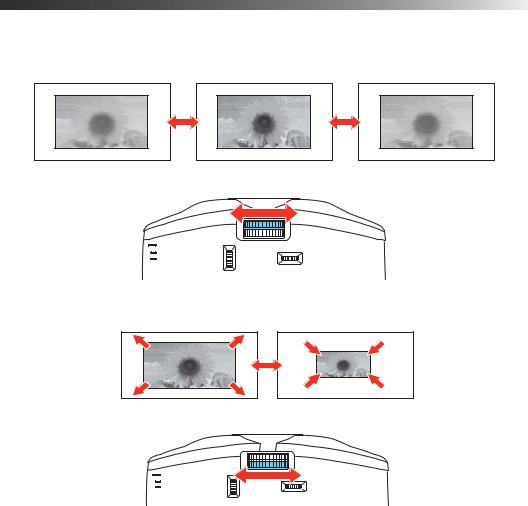
Making Basic Adjustments
Follow the instructions in this chapter to make basic adjustments to the image shape, size, color, and quality. For further refinements, see “Making Detailed Adjustments” on page 34.
Focusing and Zooming
Use the focus ring to sharpen the image.
Use the zoom ring to reduce or enlarge the image.
Making Basic Adjustments 25
